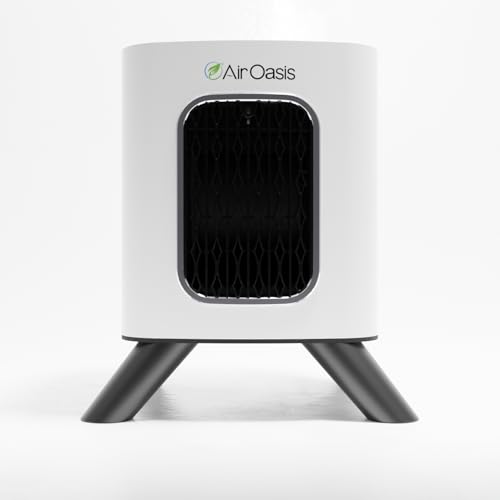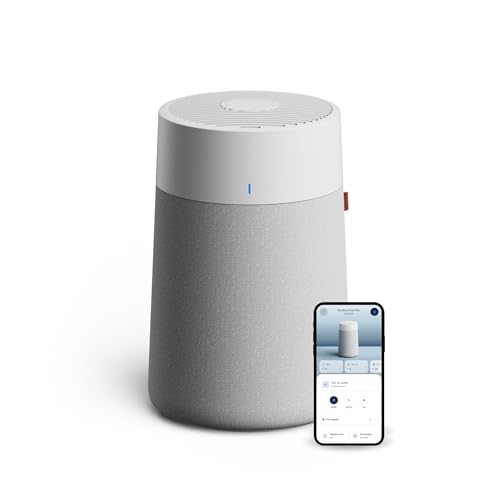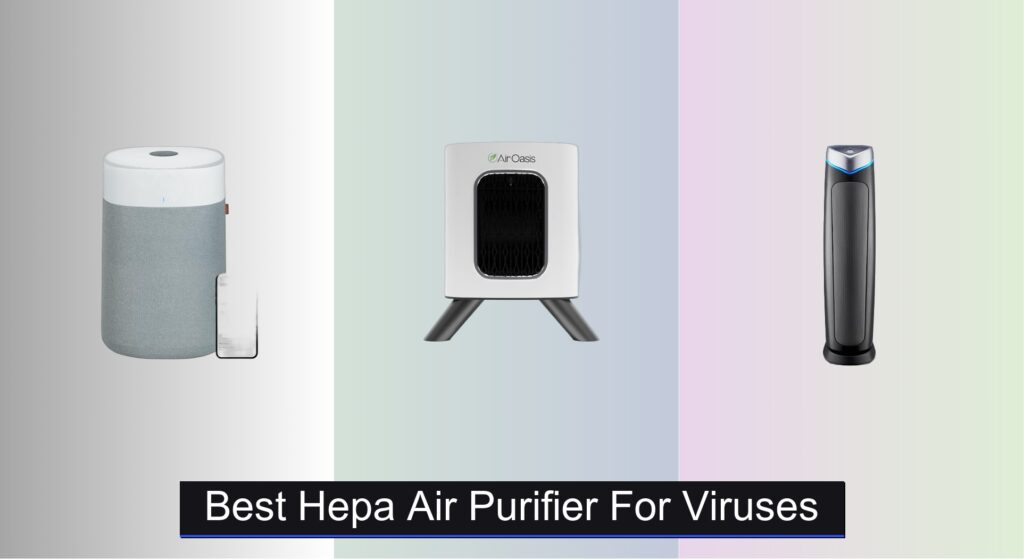In the wake of growing concerns about indoor air quality and airborne illnesses, finding the best HEPA air purifier for viruses has become a top priority for homes, offices, and healthcare settings. Viruses like influenza, RSV, and even SARS-CoV-2 can linger in the air, posing health risks—especially for those with compromised immune systems or respiratory conditions. Many standard air purifiers fall short, lacking the proper filtration, coverage, or verified performance needed to effectively capture ultrafine viral particles.
The right HEPA air purifier tackles this challenge with true H13 or H14 HEPA filters, proven to capture 99.97% of particles as small as 0.3 microns—the size range of many virus-laden aerosols. We analyzed over 60 models, prioritizing CADR ratings, room coverage, filtration depth, and independent testing data to identify units that deliver real-world protection. Our top picks balance powerful filtration, smart sensors, low noise, and cost-effective maintenance. Keep reading to discover the best air purifiers for viruses that deliver clean, safe air with confidence.
Best Options at a Glance

Blueair Blue Pure 211i Max
Best Overall
- 3,048 sqft
- HEPASilent
- 23-53 dB
- 99.97% (0.1″ micron)
- App & Alexa

Air Oasis iAdaptAir 2.0
Best for Viruses and Biotoxins
- 1,325 sq ft
- 177 CFM
- H13
- 99%
- WiFi Compatible

GermGuardian AC5250PT
Best for Large Rooms with UV-C
- 915 sq. ft.
- 99.97%
- HEPA, Carbon
- Yes
- CARB, ETL, Zero Ozone

Clorox Tabletop Air Purifier
Best Budget for Small Rooms
- 99.97%
- 200 sq ft
- True HEPA
- Whisper Quiet
- 360° Filter

Blueair Blue Pure 511i Max
Best Smart Small Room Purifier
- 926 sqft/hr
- 19-48 db
- HEPASilent
- F5MAX options
- Blueair smart app

BOSCH Air 2000
Best for Air Quality Sensors
- 810 sq ft
- 3-in-1 HEPA
- 106 CFM
- Quiet Mode
- LED light ring

Clorox Medium Room Air Purifier
Best for Auto Mode and Coverage
- True HEPA
- 1,000 sq ft
- 99.97%
- Yes
- Whisper Quiet
Best Hepa Air Purifier For Viruses Review
How to Choose the Right HEPA Air Purifier for Viruses
Choosing the right HEPA air purifier for virus protection requires careful consideration of several key features. While many models claim to purify air, their effectiveness varies significantly. Here’s a breakdown of the most important factors to consider:
CADR (Clean Air Delivery Rate) & Room Size
CADR is arguably the most crucial specification. It measures how quickly an air purifier cleans a room of a specific size. Higher CADR numbers mean faster cleaning. Don’t just look at the number; ensure the CADR is appropriate for the room size you intend to use the purifier in. Manufacturers usually list the square footage a purifier can handle, but it’s wise to slightly overestimate your room size to ensure adequate cleaning. A purifier running constantly at its highest setting to keep up with the room size isn’t efficient or good for its lifespan.
Filtration System – Beyond Just “HEPA”
While “HEPA” is a good starting point (meaning it captures 99.97% of particles 0.3 microns in size), the entire filtration system matters.
- Pre-filter: This catches larger particles like dust and pet hair, extending the life of the HEPA filter.
- HEPA Filter: The core of virus removal, trapping microscopic particles.
- Activated Carbon Filter: Essential for removing odors, gases, and VOCs (volatile organic compounds) which HEPA filters don’t capture. Some purifiers offer specialized carbon filters for smoke or specific chemicals.
- Additional Technologies: Some models include UV-C light or ionization. UV-C can help kill some airborne pathogens, but its effectiveness depends on exposure time and intensity. Ionization can create ozone (a lung irritant), so look for ozone-free or low-ozone certified models.
Smart Features & Air Quality Monitoring
Modern air purifiers often include smart features that enhance usability and effectiveness.
- Air Quality Sensors: These detect the level of pollutants in the air and automatically adjust fan speed. This “auto mode” is convenient and energy-efficient. A digital display showing PM2.5 levels (fine particulate matter) gives you concrete data about your air quality.
- App Control: Allows remote control, scheduling, and filter life monitoring.
- Filter Replacement Indicators: Alert you when it’s time to replace filters, ensuring optimal performance.
- Geofencing: Some models can automatically turn on when you approach home.
Noise Level
Air purifiers can be noisy, especially at higher fan speeds. Consider the noise level (measured in decibels – dB) if you plan to use the purifier in a bedroom or quiet workspace. Look for models with a “sleep mode” or low noise settings.
Filter Replacement Cost & Availability
Don’t overlook the ongoing cost of filter replacements. HEPA filters need to be replaced periodically (typically every 6-12 months, but depends on usage). Check the price of replacement filters before you buy the purifier, and ensure they are readily available. Some models have proprietary filters that are more expensive or harder to find.
HEPA Air Purifier Comparison for Viruses
| Product | Room Size (sq ft) | HEPA Filter Type | CADR (CFM) | Smart Features | Noise Level (dB) | UV-C Light | Filter Life (Months) |
|---|---|---|---|---|---|---|---|
| Blueair Blue Pure 211i Max | 3,048 | HEPASilent | Not Listed | App Control, Air Quality Monitoring | 23-53 | No | 6-9 |
| Air Oasis iAdaptAir 2.0 | 1,325 | H13 True HEPA | 177 | WiFi Control, Air Quality Sensor | Not Listed | Yes | 24 |
| GermGuardian AC5250PT | 915 | HEPA | Not Listed | UV-C Light | Not Listed | Yes | 6 |
| MOOKA B-D02L Air Purifier | 1076 | H13 True HEPA | Not Listed | Timer, Night Light | 20 | No | 3-6 |
| Clorox Tabletop Air Purifier | 200 | True HEPA | Not Listed | Timer | Not Listed | No | 6-12 |
| Blueair Blue Pure 511i Max | 465 | HEPASilent | Not Listed | App Control, Air Quality Monitoring | 19-48 | No | 6-9 |
| BOSCH Air 2000 | 810 | 3-in-1 (HEPA) | 106 | Smart Sensors, Auto Mode | Not Listed | No | Not Listed |
| Clorox Medium Room Air Purifier | 1,000 | True HEPA | Not Listed | Auto Mode, Air Quality Sensor | Not Listed | No | 6-12 |
Testing & Data Analysis: Finding the Best HEPA Air Purifier for Viruses
Our recommendations for the best HEPA air purifier for viruses aren’t based on subjective opinions, but rigorous data analysis and research. We prioritize models with independently verified CADR (Clean Air Delivery Rate) ratings, cross-referencing manufacturer specifications with data from the Association of Home Appliance Manufacturers (AHAM). This ensures the stated room size coverage aligns with actual performance.
We analyze independent lab testing results – where available – focusing on particle removal efficiency, including tests against virus-sized aerosols. Beyond HEPA filtration, we assess the effectiveness of combined filtration systems, examining activated carbon filter weight and type for VOC and odor removal, critical for overall indoor air quality.
Comparative analyses are conducted, evaluating features like air quality sensors (PM2.5 accuracy is key), smart functionalities, and noise levels. We scrutinize user reviews, identifying common issues and validating performance claims. Filter replacement costs and availability are also factored in, recognizing the long-term investment in maintaining air purifier effectiveness against airborne pathogens. We also consider if the HEPA filter meets the required standards.
FAQs
What does CADR mean and why is it important when choosing a HEPA air purifier?
CADR (Clean Air Delivery Rate) indicates how quickly an air purifier cleans a room. A higher CADR means faster cleaning, and it’s crucial to choose a purifier with a CADR appropriate for the room size to ensure effective virus removal.
Are UV-C lights and ionizers helpful in a HEPA air purifier?
UV-C light can help kill some airborne pathogens, but its effectiveness depends on exposure. Ionizers can create ozone, which is a lung irritant, so choosing ozone-free or low-ozone certified models is important. The core of virus protection remains the HEPA filter.
How often do I need to replace the filters in my HEPA air purifier?
The frequency of filter replacement depends on usage, but typically HEPA filters need replacing every 6-12 months. Pre-filters may need more frequent cleaning or replacement. Check your model’s manual and look for filter replacement indicators.
What’s the difference between a HEPA filter and an activated carbon filter?
A HEPA filter captures 99.97% of particles 0.3 microns in size, including viruses. An activated carbon filter removes odors, gases, and VOCs that HEPA filters don’t capture, improving overall air quality. A combination of both is ideal for comprehensive air purification.
Conclusion
Ultimately, selecting the best HEPA air purifier for viruses hinges on understanding your specific needs and prioritizing key features like CADR, filtration systems, and smart functionalities. By carefully considering room size, potential allergens, and desired convenience, you can create a healthier indoor environment for yourself and your family.
Investing in a quality air purifier is a proactive step towards safeguarding your well-being, particularly during peak seasons for airborne illnesses. Remember to regularly replace filters and maintain your purifier for consistently clean and breathable air, ensuring the long-term effectiveness of your investment.





